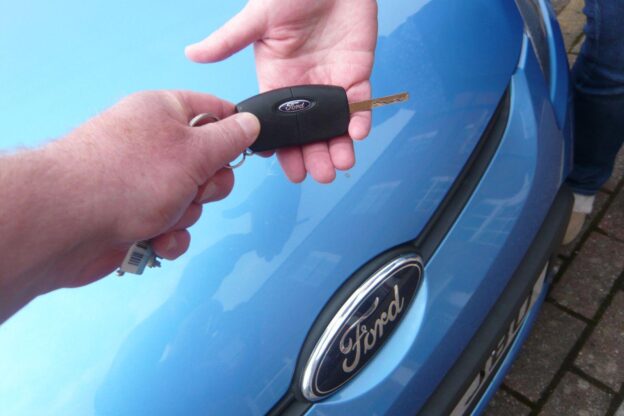Car Keys Explained
Since 1995, all cars manufactured and sold in the UK are legally required to be fitted with an immobiliser system. This was introduced as means to deter criminals from breaking and entering a vehicle. In order to start the vehicle, a key with an electronic transponder that holds a unique code is required. When the key is placed into the ignition of the vehicle, the car will only start if the code received from the key matches that of the vehicle. This also means that should your transponder in your key break, your vehicle will not start.
The majority of modern vehicle keys are a combination of three keys (outlined below).
1. A Mechanical Key
(The metal part of the key that is used to manually open doors and is placed in the ignition barrel to release the steering lock)
Types of mechanical keys & how they are made
Unsurprisingly there are more car key designs today than ever before. However you may be interested to know that car keys are cut using one of only two techniques: mechanical key duplication or laser cutting.
Mechanical Cut Car Keys
The mechanical cut car key is the more traditional method of the two. This is where a pattern is cut along one edge of the blade. Mechanical cut automotive keys are made on a mechanical key cutting machine or die-punch - it's the same technique a locksmith would use to make a new key for your front door, motor home, or home safe. In fact, this was the only method of key duplication up until the late part of the 20th century when laser key cutting was introduced. Today, mechanical car keys are still popular amongst some domestic models such as Ford, Vauxhall and some foreign models, and still remain the most widely used key on the market. However the more modern, and arguably more secure; laser cut keys continue to gain popularity year on year.
Laser Cut Car Keys
Laser cut car keys are the more advanced technique of the two. Often referred to as ‘sidewinder’ or ‘internal cut’; laser keys have blunt or square edges with identical cuts on both flat sides of the blade. Unlike mechanical keys, these will fit in a car's ignition either way.
Laser keys offer a number of security advantages, including the fact that their lock cylinders are harder to pick than traditional ones. They require the use of specialized software and a high-tech laser cutting machine for production. These machines are not only expensive, but they require more training to operate properly - car dealers and automotive locksmiths are typically the best-equipped for the task of duplicating laser keys. While luxury cars like Mercedes and Audi were the first to offer the "premium" laser cut key. The decreased costs and an increased availability has allowed for automakers such as Honda and Kia to adopt the more sophisticated technology for their latest makes and models.
2. A Coded Electronic Transponder Chip
(Where the key is inserted into the ignition and is read by the car)
Transponder Chip
Introduced in 1995, the electronic, coded transponder chip is embedded into the plastic body of the key, the code is read when you turn the key in the ignition; the chip does not need batteries as it is passive. The engine will not start if the transponder chip is lost or broken.
Rolling Codes
Transponders originally used ‘fixed codes’ where the key sends the same coded signal every time it’s used. Today keys with ‘rolling codes’ are very common which means the transponder code changes every time the key is used. The keys were introduced in 1999 and can significantly improve security, however, they can be extremely expensive to replace.
Master Keys
A ‘master key’ was usually supplied with many early cars and was not intended for normal use. The master key is used to programme a new or replacement key for the car. If the master key is lost or damaged it may prove a costly mistake.
Nowadays car manufacturers have more or less stopped using master keys. Vehicle specific security information is now held in a central database which is used to reprogram the car and a replacement key. When buying a used car, you should make sure you get all of the keys including the master key if one was supplied when the car was first bought.
3. A Remote Control
(Locks and unlocks the doors and turns off the alarm)
Remote controls are supplied with nearly all new cars to lock and unlock doors as well as disable the alarm. Commonly they use a radio transmitter to send a coded signal to a receiver on the car, however some do use infrared. For the most part these remotes are powered by batteries.
On occasion, third party interference can affect your remote and in the worst case scenario, could leave you being unable to unlock your vehicle. Although less of a problem for modern cars, the issue still remains for older cars: especially those built before 1995.
Is your remote control not working?
First check the battery, or if you suspect radio interference try using the remote control nearer to your car.
There should be a bypass system in cars with central locking, using the normal metal key to unlock the doors without setting the alarm off. Vehicles that come with keyless entry (i.e. the car door opens when you approach even if the key fob is in your pocket), have an auxiliary entry system, usually involving a key being used in a hidden lock. The location of the hidden keyhole is different for many manufactures and is explained in the car’s manual.
A broken or lost transponder car key will result in the vehicle not starting. Mobile professional auto locksmiths LOCKFiX24 use the latest transponder key programming and key cutting technology to be able to produce replacement keys for the majority of vehicles in a matter of minutes.
